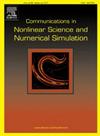Competitive influence maximization in voter dynamics: The role of timing and network heterogeneity
IF 3.8
2区 数学
Q1 MATHEMATICS, APPLIED
Communications in Nonlinear Science and Numerical Simulation
Pub Date : 2025-02-14
DOI:10.1016/j.cnsns.2025.108670
引用次数: 0
Abstract
In the study of influence maximization, most existing research often assumes a one-off resource allocation at the start of a competition. As a result, they overlook the benefits of dynamic, time-sensitive strategies. To overcome this limitation, we propose a novel approach using inter-temporal allocations within a non-progressive voter model to optimize the timing and distribution of limited resources for maximizing opinion spread. Our objective is twofold: (i) to provide understanding of patterns of opinion spread in complex networks subject to inter-temporal control, and (ii) to use insights from (i) to develop optimization strategies that balance resource constraints and temporal dynamics. Specifically, our study examines two scenarios: a constant-opponent setting and a game-theoretical framework. In the constant-opponent setting, we find that network heterogeneity significantly influences optimal campaign timing, with late initiation benefiting short time horizons in heterogeneous networks and early starts favoring longer horizons. To further enhance this strategy, we introduce a node-specific optimization strategy that outperforms uniform approaches, especially under resource constraints. In the game-theoretical framework, our results reveal that resource-rich controllers tend to start campaigns early, while resource-limited controllers strategically delay to counter their opponent’s advantage. Through analytical approximations and simulations, we provide insights into the temporal dynamics of influence spread. These findings offer practical guidelines for designing effective influence campaigns in competitive and time-sensitive contexts, with applications in marketing, politics, and public health.
选民动态中的竞争影响最大化:时间和网络异质性的作用
在影响力最大化的研究中,大多数现有研究通常假设在竞争开始时进行一次性资源分配。因此,他们忽视了动态的、时效性强的策略的好处。为了克服这一限制,我们提出了一种新的方法,在非渐进式选民模型中使用跨时间分配来优化有限资源的时间和分配,以最大化意见传播。我们的目标是双重的:(i)提供对受跨时间控制的复杂网络中意见传播模式的理解,以及(ii)利用(i)的见解制定平衡资源约束和时间动态的优化策略。具体来说,我们的研究考察了两种情况:持续对手设置和博弈论框架。在恒对手环境下,我们发现网络异质性显著影响最优运动时机,在异构网络中,较晚开始有利于较短的时间范围,而较早开始有利于较长的时间范围。为了进一步增强该策略,我们引入了一个特定于节点的优化策略,该策略优于统一的方法,特别是在资源约束下。在博弈论框架中,我们的研究结果表明,资源丰富的控制者倾向于尽早开始行动,而资源有限的控制者则会在战略上推迟行动以对抗对手的优势。通过分析近似和模拟,我们提供了对影响传播的时间动态的见解。这些发现为在竞争激烈和时间敏感的环境中设计有效的影响力活动提供了实用指南,并可应用于市场营销、政治和公共卫生。
本文章由计算机程序翻译,如有差异,请以英文原文为准。
求助全文
约1分钟内获得全文
求助全文
来源期刊

Communications in Nonlinear Science and Numerical Simulation
MATHEMATICS, APPLIED-MATHEMATICS, INTERDISCIPLINARY APPLICATIONS
CiteScore
6.80
自引率
7.70%
发文量
378
审稿时长
78 days
期刊介绍:
The journal publishes original research findings on experimental observation, mathematical modeling, theoretical analysis and numerical simulation, for more accurate description, better prediction or novel application, of nonlinear phenomena in science and engineering. It offers a venue for researchers to make rapid exchange of ideas and techniques in nonlinear science and complexity.
The submission of manuscripts with cross-disciplinary approaches in nonlinear science and complexity is particularly encouraged.
Topics of interest:
Nonlinear differential or delay equations, Lie group analysis and asymptotic methods, Discontinuous systems, Fractals, Fractional calculus and dynamics, Nonlinear effects in quantum mechanics, Nonlinear stochastic processes, Experimental nonlinear science, Time-series and signal analysis, Computational methods and simulations in nonlinear science and engineering, Control of dynamical systems, Synchronization, Lyapunov analysis, High-dimensional chaos and turbulence, Chaos in Hamiltonian systems, Integrable systems and solitons, Collective behavior in many-body systems, Biological physics and networks, Nonlinear mechanical systems, Complex systems and complexity.
No length limitation for contributions is set, but only concisely written manuscripts are published. Brief papers are published on the basis of Rapid Communications. Discussions of previously published papers are welcome.
 求助内容:
求助内容: 应助结果提醒方式:
应助结果提醒方式:


